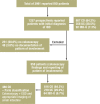Inflammatory bowel disease in pediatric patients: Characteristics of newly diagnosed patients from the CEDATA-GPGE Registry
- PMID: 25759978
- PMCID: PMC4361801
- DOI: 10.3238/arztebl.2015.0121
Inflammatory bowel disease in pediatric patients: Characteristics of newly diagnosed patients from the CEDATA-GPGE Registry
Abstract
Background: Inflammatory bowel disease (IBD) can arise at any age, with peak incidence in adolescence and young adulthood. A registry of pediatric cases of IBD offers the opportunity to document their diagnosis and treatment, with the ultimate aim of improving diagnosis and treatment in the future.
Methods: In the German-language CEDATA-GPGE registry, 3991 cases of IBD in patients less than 18 years of age were documented from 2004 to 2014. The 1257 patients who were prospectively included in the registry upon diagnosis and whose further course was documented for at least three months were analyzed in two separate groups--under 10 years old, and 10 years and above--with respect to the type and duration of their symptoms until diagnosis, the completeness of the diagnostic evaluation, the disease phenotype, and the initial treatment.
Results: Of the 958 patients for whom full documentation was available, 616 (64.3%) had Crohn's disease (CD), 278 (29%) had ulcerative colitis (UC), 64 (6.7%) had an unclassified IBD, and 23.2% were under 10 years old. The latency to diagnosis was longer for CD than for UC (0.5 versus 0.3 years), regardless of age. 62.5% of the CD patients had ileocolonic involvement, and more than half had involvement of the upper gastrointestinal tract. 71% of the patients with UC had subtotal colitis or pancolitis. Continuous improvement was seen in diagnostic assessment according to published guidelines. For example, in 2004/2005, 69% of patients were evaluated endoscopically with ileocolonoscopy and esophagogastroduodenoscopy; this fraction had risen to nearly 100% by 2013/2014. Similarly, the percentage of patients who underwent a diagnostic evaluation of the small intestine, as recommended, rose from 41.2% to 60.9% over the same period. The most common initial treatments were 5- amino - salicylates (86.8% CD, 100% UC) and glucocorticoids (60.6% CD, 65.6% UC). 32% of the patients with CD received exclusive enteral nutrition therapy.
Conclusion: Most of these pediatric patients with IBD, whether in the younger or the older age group, had extensive bowel involvement at the time of diagnosis. The registry data imply that improvement in clinical course may be achieved by shortening the time to diagnosis and by closer adherence to the diagnostic and therapeutic guidelines.
Figures








Comment in
-
Poor Data Quality.Dtsch Arztebl Int. 2015 Aug 3;112(31-32):544. doi: 10.3238/arztebl.2015.0544a. Dtsch Arztebl Int. 2015. PMID: 26334982 Free PMC article. No abstract available.
-
In Reply.Dtsch Arztebl Int. 2015 Aug 3;112(31-32):544. doi: 10.3238/arztebl.2015.0544b. Dtsch Arztebl Int. 2015. PMID: 26334983 Free PMC article. No abstract available.
References
-
- Kelsen J, Baldassano RN. Inflammatory bowel disease: the difference between children and adults. Inflamm Bowel Dis. 2008;14:9–11. - PubMed
-
- Benchimol EI, Fortinsky KJ, Gozdyra P, van den HM, van LJ, Griffiths AM. Epidemiology of pediatric inflammatory bowel disease: a systematic review of international trends. Inflamm Bowel Dis. 2011;17:423–439. - PubMed
-
- Molodecky NA, Soon IS, Rabi DM, et al. Increasing incidence and prevalence of the inflammatory bowel diseases with time, based on systematic review. Gastroenterology. 2012;142:46–54. - PubMed
-
- Benchimol EI, Guttmann A, Griffiths AM, et al. Increasing incidence of paediatric inflammatory bowel disease in Ontario, Canada: evidence from health administrative data. Gut. 2009;58:1490–1497. - PubMed
-
- Auvin S, Molinie F, Gower-Rousseau C, et al. Incidence, clinical presentation and location at diagnosis of pediatric inflammatory bowel disease: a prospective population-based study in northern France (1988-1999) J Pediatr Gastroenterol Nutr. 2005;41:49–55. - PubMed
Publication types
MeSH terms
Substances
LinkOut - more resources
Full Text Sources
Other Literature Sources
Medical

